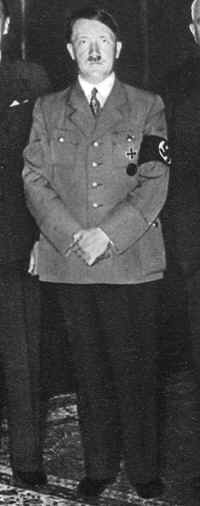
The Führer Principle came to dominate Nazi Germany after Adolf Hitler was appointed Chancellor on January 30th 1933. The Führer Principle played its part within the Nazi Party in the lead up to 1933 but there were challenges to the would-be Führer from the likes of Gregor Strasser and Walter Stennes. After Hitler’s appointment as Chancellor, however, a person questioned the Führer Principle at their peril.
The Führer Principle was a very simple concept. Rudolf Hess probably best summarised the Führer Principle when he said in a public speech:
“Hitler is Germany and Germany is Hitler. Whatever he does is necessary. Whatever he does is successful. Clearly the Führer has divine blessing.”
The Führer Principle required everyone in Nazi Germany to accept that Hitler had all the solutions to Germany’s problems and that whatever he said had to be right. On the day after the Night of the Long Knives Hitler defended the action of the SS by stating that for 24 hours he had become the law in Germany and that the SS were simply carrying out his orders. The Führer Principle in its most basic form was that what Hitler said had to be carried out or if it was not the person who challenged it was betraying Hitler and therefore Germany.
The propaganda machine went into overdrive to portray Hitler as the leader who put his country before anything else – hence why he was not married until the very end as he was ‘married’ to Germany. Images of Hitler with Eva Braun were highly restricted and controlled by the state. Such was the effectiveness of Goebbels propaganda machine, that a great many people in Nazi Germany never even knew that Hitler had a girlfriend/mistress until after the end of World War Two in Europe.
The Führer Principle became embedded into everyday life in Nazi Germany. The formal greeting of ‘Heil Hitler’ was an effective requirement and children were required to use the salute both on their way to school and once there. They were also told that they should report their parents if they were seen doing the salute/greeting in a half-hearted manner.
With the cinema and newspapers controlled by the state, Goebbels had total freedom in the way he portrayed the Führer. Goebbels stated:
“We are witnessing the greatest miracle in history. A genius is building the world. We heard his voice while Germany slept. His hand has made us a nation again. His hand has led us back to the Fatherland. Our whole life we give to the Führer.”
On another occasion, the man who controlled radio broadcasts, newspapers and the cinema stated:
“He alone is never mistaken. He is always right. Amazing how great the Führer is in his simplicity and how simple in his greatness. He is above us all. He is always like a great star above us.”
Nazi leaders vied with one another to portray Hitler as having messianic status.
“And then unto us was born a child in Brannau.” (Hess)
“The Lord has sent us Adolf Hitler.” (Robert Ley)
“God has manifested himself not in Jesus Chris but in Adolf Hitler.” (GermanFaith Movement)
“We believe that God has sent us Adolf Hitler so that Germany should be a foundation stone in all eternity.” (Hitler Youth)
Such references all revolved around the Führer Principle – the man who should have total control over Germany and expect total obedience. Myths grew about Hitler that bordered on the absurd but no one dared question them in a police state like Nazi Germany. When a university lecturer claimed that her dog could say the words ‘Adolf Hitler’ when the dog saw a photograph of the Führer, it was accepted. Even during the bombing campaign of World War Two, the rumour was allowed to spread that the bombs that were dropped were incapable of destroying a portrait of Hitler even in a bombed out house. The house may have been destroyed but the portrait was not.
To maintain the whole Führer Principle psyche, no one was allowed to tell a joke about the Führer unless they wanted to risk a spell in a concentration camp. In the warped legal system of Nazi Germany a joke about the Führer could have been viewed as treason. Even good weather was known as ‘Führer Weather’.
July 2012
Related Posts
- Adolf Hitler led Germany throughout World War Two. His desire to create an aryan race was paramount in his ethos and political campaigns. Hitler had no…
